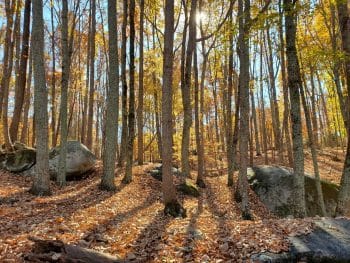NEWS
Davidson Lands Conservancy Mounts Capital Campaign

Davidson Lands Conservancy capital campaign targets protection of undeveloped land, trees, greenways, wildlife habitat.
The Davidson Lands Conservancy is at the midpoint of a three-year effort to raise $1.75 million, its largest capital campaign, to protect undeveloped land and wildlife habitat, replant native trees, and extend greenways.
The Now & Forever campaign, launched last year, has already raised $1.4 million, mostly from individual donors. The campaign is now asking for corporate gifts as it pushes toward its goal line by the end of 2024.
Founded in 2000, the nonprofit Conservancy is among the smallest of North Carolina’s nationally-accredited land trusts and is closely focused on the Davidson area. It first organized to help offset the development rapidly overtaking rural areas and small towns around Charlotte.

The Davidson Lands Conservancy is in the midst of a $1.75 million capital campaign, with protecting an additional 650 acres of undeveloped land among its goals. (Photo courtesy of Davidson Lands Conservancy.)
In the span of about two generations, UNC Charlotte researchers have projected, the percentage of undeveloped natural land in Mecklenburg County will shrink from 87 percent in 1976 to just 3 percent by 2030.
The Conservancy does not oppose development, but it seeks to balance it by strategically protecting land with high conservation values. As it evolved and grew, the trust developed additional focus areas that are reflected in the four “pillars” set for the three-year campaign.
- Land conservation: Add at least 650 acres to the approximately 350 acres the Conservancy has already protected. A key tool is conservation easements, legal agreements that landowners donate or sell to permanently prevent development that would harm waterways, forests, wildlife habitat, or farms. Donor dollars can help cover transaction costs, occasionally compensate landowners, or provide matching funds for grants.
- Greenways and trails: Work with the town to connect the West Branch greenway, which winds through the Abersham and Fisher Farm parks east of Davidson, to the new Narrow Passage neighborhood off Shearer Road. Interpretive signage and “wayfinding” guides would be installed.
- Urban forestry: Plant 600 native trees, adding to the more than 500 the Conservancy’s TreesDavidson program has already planted. The campaign would extend the Treasure Tree program, which recognizes Davidson’s biggest, oldest, or most unique specimens. It would also continue collaboration with the town on stewardship of the tree canopy, which covers about half Davidson’s land area but is declining by about 1 percent a year.
- Wildlife and habitats: Develop a wildlife management plan for the 545-acre Abersham and Fisher Farm parks, on which the Conservancy collaborates with the county and town on stewardship. Wildlife corridors, which often follow streams, would also be inventoried and landowners contacted to collaborate in managing them.
The benefits? Cleaner local water and air, less carbon in the atmosphere, and more outdoor recreation. Protecting sensitive ecosystems, the Conservancy says, helps mitigate climate change, increase biodiversity, reduce flooding, and preserve Davidson’s rural roots.
John Griffith, the Conservancy board member who leads the campaign, said its initial focus was to introduce DLC to interested community members, some of whom knew little about land trusts or the costs of conservation. But most agreed that they want to protect Davidson’s leafy, rural vibe.
“People love green space, and still move here in part because of that, and they want to protect it,” said Griffith, a former Davidson College admissions and fundraising leader who also served as president of two other colleges.
More than 200 residents attended presentations at a dozen local homes over the first two years of the campaign, and those gatherings continue as word of it spreads. At this point, Griffith said, $1.4 million is conservatively calculated to have been donated, pledged, or expected in revenues from sources such as the annual Run for the Green by the start of 2025.
The result, Griffith said, will be to expand the Conservancy’s universe of donors, some of whom will continue to support it after the capital campaign ends. That, in turn, will help leave a stable conservation organization that is regarded as an essential part of Davidson.
Board member Scott Tew, the Trane Technologies vice president of sustainability who leads the campaign’s corporate giving effort, said companies have been “overwhelmingly positive” about giving to DLC. About two dozen companies from the Lake Norman area were represented at a luncheon in June, and individual follow-up meetings are underway.
“Land conservation is probably misunderstood by most people – I know it was for me in terms of what it takes to set aside the land and place the requirements to steward the land in the right way,” he said.
The campaign’s four pillars help companies find especially appealing aspects of the Conservancy’s work, Tew said. Many companies, for example, are interested in volunteer opportunities for their employees.
“Almost any company cares about at least one of those pillars,” he said. “Our view is that if you care about those, and your employees do, this might be a great time to partner with DLC on next steps.”
Bruce Henderson
Bruce Henderson recently retired from the Charlotte Observer, where he wrote about the environment for two decades. He’s a Morganton native, proud UNC Chapel Hill grad, and supporter of the Davidson Lands Conservancy. Bruce and his wife Lynn have lived in Davidson since 1985.


